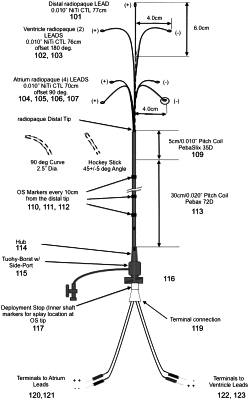| CPC A61N 1/0565 (2013.01) [A61L 29/02 (2013.01); A61L 29/06 (2013.01); A61L 29/085 (2013.01); A61L 29/18 (2013.01); A61M 25/0108 (2013.01); A61M 25/0147 (2013.01); A61M 25/0662 (2013.01); A61N 1/3622 (2013.01); A61N 1/36507 (2013.01); A61N 1/371 (2013.01); A61N 1/37217 (2013.01); A61M 2205/0266 (2013.01)] | 34 Claims |

|
1. An electrode system connectable to a pacemaker for sequentially pacing both the atrium and ventricle of a human heart comprising:
a plurality of insulated electrical leads comprising a first set of ventricle leads and a second set of atrium leads, wherein the first set of ventricle leads comprises three ventricle leads and the second set of atrium leads comprises four atrium leads, wherein the first set of ventricle leads and the second set of atrium leads are adapted to reduce contact-induced endothelial injury and reduce thrombotic formation, each lead of the three ventricle leads and of the atrium leads having a tissue-contact end connected to a conductive wire, the tissue-contact end having a blunt, rounded, curled, or looped shape, the conductive wire having a fibrin-resistant coat along at least a part thereof, the fibrin-resistant coat comprised of silicone, siloxane, PEEK, PET, PFTE, or polymer doped with a releasable anti-coagulant drug or anti-inflammatory drug,
an outer catheter sheath disposed over said plurality of leads,
a first inner sheath and a second inner sheath inside a lumen of the outer catheter sheath, the first inner sheath disposed over the ventricle leads and the second inner sheath disposed over the atrium leads, the outer catheter sheath and first inner sheath being retractable from the ventricle leads to a first position to deploy the ventricle leads in the ventricle, each of the ventricle leads having a resiliency and shape to be deployed in contact with the ventricle wall, the outer catheter sheath and second inner sheath being retractable from the atrium leads to a second position to deploy the atrium leads in the atrium, each of the atrium leads having the resiliency and shape to be deployed in contact with the atrium wall, wherein the electrode system is withdrawable from the heart so that the atrium leads are returnable from the second position to the first position to capture the atrium leads in a lumen of the second inner sheath and the ventricle leads are returnable from the first position to an original position to capture the ventricle leads in a lumen of the first inner sheath at an anatomical location of the heart above the SVC-RA junction
the outer catheter sheath being retractable from the ventricle leads to deploy the ventricle leads in the ventricle, each of the ventricle leads having a resiliency and shape to be deployed in contact with the ventricle wall when the sheath is retracted therefrom,
the outer catheter sheath also being retractable from the atrium leads to deploy the atrium leads in the atrium, each of the atrium leads having the resiliency and shape to be deployed in contact with the atrium wall when the sheath is retracted,
wherein the ventricle leads are not attachable to the ventricle wall, but are adapted to contact the ventricle wall, and the atrium leads are not attachable to the atrium wall, but are adapted to contact the atrium wall.
|